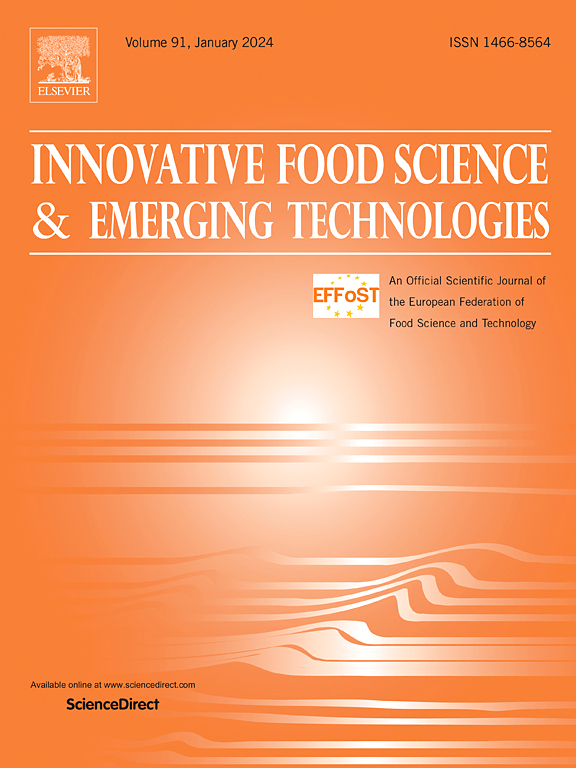Mechanistic modelling and simulation of instant decompression assisted novel steaming treatment for the characterization of no cooking rice-a new insight
IF 6.3
1区 农林科学
Q1 FOOD SCIENCE & TECHNOLOGY
Innovative Food Science & Emerging Technologies
Pub Date : 2025-04-11
DOI:10.1016/j.ifset.2025.104016
引用次数: 0
Abstract
Instant controlled pressure drop (ICPD) treatment is an emerging technology involving high-pressure saturated steam treatment in combination with instant vacuum decompression. The treatment reactions were simulated based on mechanistic modelling approach for the characterization of novel no cooking rice. The process involves treating post-harvested or soaked post-dried paddy with saturated steam (0.1–0.5 MPa for 150–100 s), and drying at 40–60 °C temperature. Standardized process conditions as obtained from the optimization were treatment pressure of 0.5 MPa, treatment time of 150 s, and degree of polishing of 12 % with maximum rehydration ratio of 4.16 and minimum cooking time of 5 min. The rice underwent gelatinization during ICPD treatment, exhibiting first-order kinetics and a progressive increase in gelatinization values as the treatment pressure varied. Further indications of enhanced quality attributes, such as cooking and rehydration, were discernible from the results of scanning electron microscopy (SEM) and X-ray diffraction (XRD) data and also based on the interpretation of hydration, drying, and rehydration kinetics. From the results of XRD, V and B-type peaks could be observed and interpreted in ICPD-treated rice due to the formation of amylose–lipid complex and retrogradation of starch molecules during parboiling. Besides, ICPD-treatment filled rice cracks progressively owing to starch gelatinization, according to SEM data. Soaking leaches starch out and plugs all the pores and fractures in the kernel, while steaming causes it to swell and expand, creating a smooth surface and filling gaps.

机械建模和模拟的即时减压辅助新型蒸处理表征不煮大米-一个新的见解
即时控制压降(ICPD)处理是一项将高压饱和蒸汽处理与即时真空减压相结合的新兴技术。采用机械建模方法模拟了新型免煮大米的处理反应。该工艺包括用饱和蒸汽(0.1-0.5 MPa, 150-100 s)处理收获后或浸泡后干燥的水稻,并在40-60℃的温度下干燥。优化得到的标准化工艺条件为:处理压力为0.5 MPa,处理时间为150 s,抛光度为12%,最大复水化比为4.16,最小蒸煮时间为5 min。在ICPD处理过程中,大米发生了糊化,并表现出一级动力学特征,糊化值随处理压力的变化而逐渐增加。从扫描电子显微镜(SEM)和x射线衍射(XRD)数据的结果以及水化、干燥和水化动力学的解释中,可以看出进一步提高质量属性的迹象,如蒸煮和再水化。XRD分析结果表明,经icpd处理的大米在过煮过程中,由于直链淀粉-脂复合物的形成和淀粉分子的退化,形成了V型和b型峰。此外,根据扫描电镜数据,icpd处理后的大米由于淀粉糊化而逐渐开裂。浸泡会使淀粉浸出,堵塞玉米粒中的所有毛孔和裂缝,而蒸煮会使其膨胀,使表面光滑,填补空隙。
本文章由计算机程序翻译,如有差异,请以英文原文为准。
求助全文
约1分钟内获得全文
求助全文
来源期刊
CiteScore
12.00
自引率
6.10%
发文量
259
审稿时长
25 days
期刊介绍:
Innovative Food Science and Emerging Technologies (IFSET) aims to provide the highest quality original contributions and few, mainly upon invitation, reviews on and highly innovative developments in food science and emerging food process technologies. The significance of the results either for the science community or for industrial R&D groups must be specified. Papers submitted must be of highest scientific quality and only those advancing current scientific knowledge and understanding or with technical relevance will be considered.

 求助内容:
求助内容: 应助结果提醒方式:
应助结果提醒方式:


